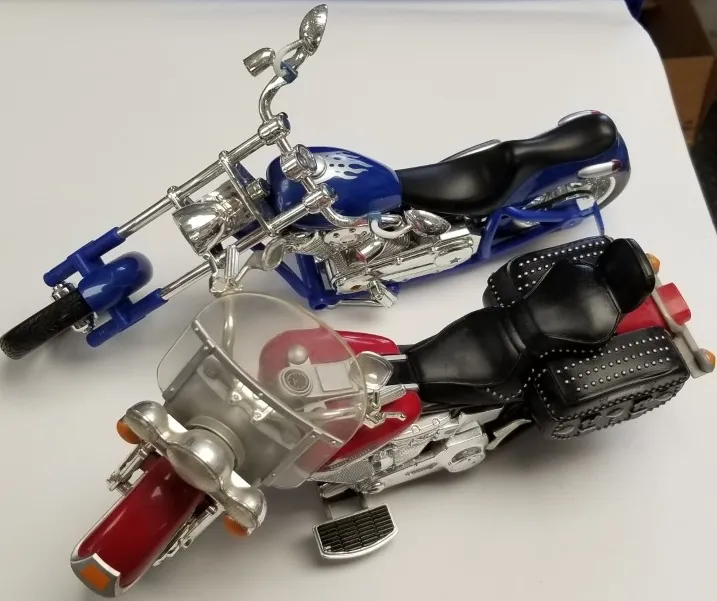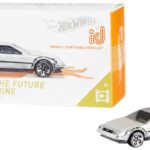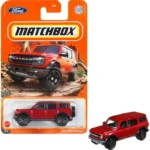Exploring the World of Toy Motorcycles
Introduction
Toy motorcycles have long held a special place in the hearts of children and enthusiasts alike. These miniature replicas of their real-life counterparts offer a gateway to imagination, adventure, and sometimes even a glimpse into the world of engineering and technology. From simple push-along models to sophisticated remote-controlled bikes, toy motorcycles come in various forms, each catering to different ages, interests, and levels of enthusiasm.
In this comprehensive guide, we will delve into the fascinating world of toy motorcycles, exploring their history, types, designs, technology, collector culture, and much more. Whether you’re a parent looking to choose the perfect toy motorcycle for your child, a hobbyist interested in the intricate details of collectible models, or simply curious about how these toys have evolved over time, this article aims to provide a detailed exploration.
History of Toy Motorcycles
Early Beginnings
The history of toy motorcycles traces back to the late 19th century, following the invention and popularization of the real-life motorcycle. Early toy motorcycles were often handmade or produced in small workshops, crafted from materials such as tin, cast iron, and later, pressed steel. These early toys were simple in design, reflecting the basic form and function of the motorcycles of their time.
20th Century Innovations
The early 20th century saw significant advancements in manufacturing techniques and materials, leading to the mass production of toy motorcycles. Companies like Märklin in Germany and Tipp & Co. in the United States pioneered the creation of clockwork motorcycles, which could be wound up to propel themselves forward. These toys delighted children with their mechanical movements and realistic appearances, setting the stage for further innovations in the decades to come.
Post-World War II Boom
The post-World War II era brought a surge of creativity and innovation to the toy industry, including toy motorcycles. Companies in Japan, such as Bandai and Nomura (TN), began producing battery-operated motorcycles with lights, sounds, and even remote control capabilities. These toys reflected the technological advancements of the time and captured the imaginations of children around the world, contributing to the global popularity of toy motorcycles as playthings.
Modern Era and Technological Advances
In recent decades, toy motorcycles have continued to evolve alongside advances in technology and manufacturing. Today’s toy motorcycles range from simple friction-powered models aimed at young children to highly detailed replicas equipped with sophisticated electronic features for collectors and hobbyists. The diversity in design and functionality caters to a broad audience, ensuring that there’s a toy motorcycle for everyone, regardless of age or interest.
Types of Toy Motorcycles
Push-Along Motorcycles
Push-along motorcycles are the simplest form of toy motorcycles, designed for young children who are just beginning to explore the world of toys. These motorcycles typically operate on friction mechanisms, where pushing the motorcycle along a surface generates kinetic energy that propels it forward. Push-along motorcycles are durable, easy to use, and encourage physical play and exploration.
Die-Cast Models
Die-cast toy motorcycles are prized by collectors and enthusiasts for their realism and attention to detail. These models are typically made from metal alloys such as zinc or aluminum, which are cast into intricate molds to replicate the appearance of real motorcycles. Die-cast models often feature movable parts, rubber tires, and authentic paint schemes, making them popular display pieces among collectors.
Remote-Controlled (RC) Motorcycles
Remote-controlled motorcycles offer an interactive and dynamic play experience, allowing users to control the motorcycle’s movements using a handheld transmitter. These motorcycles are powered by electric motors and batteries, which drive the wheels and provide propulsion. RC motorcycles may include advanced features such as gyroscopic stabilization for improved balance, LED lights, and programmable maneuvers for enhanced playability.
Battery-Operated Motorcycles
Battery-operated motorcycles are equipped with electric motors and rechargeable batteries that power their movements and features. These motorcycles often include lights, sounds, and interactive elements such as horn sounds or engine revving noises. Battery-operated motorcycles are popular among children and collectors alike for their realistic features and engaging play options.
Build-Your-Own Kits
Build-your-own motorcycle kits are educational toys that allow children and hobbyists to assemble their own motorcycle models from individual parts. These kits typically include plastic or metal components, screws, and assembly instructions, promoting hands-on learning and creativity. Building a motorcycle from a kit teaches valuable skills in engineering, problem-solving, and following instructions.
Collectible and Limited Edition Models
Collectible toy motorcycles are highly sought after by collectors for their rarity, historical significance, and aesthetic appeal. Manufacturers produce limited edition models with unique designs, special features, and commemorative themes that appeal to enthusiasts. Collectors often focus on specific brands, eras, or types of motorcycles, building extensive collections that showcase the diversity and craftsmanship of toy motorcycles.
Design and Features
Materials
Toy motorcycles are crafted from a variety of materials, each offering distinct benefits in terms of durability, aesthetics, and functionality:
- Plastic: Lightweight and affordable, plastic is commonly used for toy motorcycles aimed at young children. Plastic toys are colorful, easy to clean, and often feature rounded edges and safety-tested designs suitable for small hands.
- Metal Alloy (Die-cast): Die-cast toy motorcycles are made from metal alloys such as zinc or aluminum, which are cast into detailed molds to replicate the appearance of real motorcycles. These models are prized by collectors for their authenticity and craftsmanship.
Scale and Proportion
Toy motorcycles are available in different scales that determine their size relative to the real-life counterpart:
- 1:12 Scale: Larger models with detailed features and realistic proportions, suitable for display or play.
- 1:18 Scale: Medium-sized models that balance detail with compactness, popular among collectors and enthusiasts.
- 1:24 Scale and Smaller: Smaller models ideal for young children or collectors looking to build larger collections. These scales may sacrifice some detail for affordability and accessibility.
Features
Modern toy motorcycles may include a range of features to enhance playability and realism:
- Functional Parts: Movable components such as steering handles, kickstands, and suspensions that mimic the actions of real motorcycles.
- Lights and Sounds: Battery-operated motorcycles often feature LED lights, engine sounds, and horn or revving noises to simulate the experience of riding a motorcycle.
- Remote Control Options: Remote-controlled motorcycles allow users to steer, accelerate, and perform stunts using a handheld transmitter. Advanced models may offer proportional control, digital displays, and customizable settings for enhanced performance.
- Customization Options: Some toy motorcycles provide customization options such as interchangeable parts, decals, and accessories that allow users to personalize their motorcycles according to their preferences.
Technology Behind Toy Motorcycles
Friction Mechanisms
Friction-powered toy motorcycles use a simple mechanical mechanism to convert kinetic energy into forward motion. By pushing the motorcycle along a flat surface, friction between the wheels and the ground propels the toy forward. Friction-powered motorcycles are easy to operate and do not require batteries or external power sources, making them suitable for young children.
Battery and Electric Motors
Battery-operated toy motorcycles are equipped with electric motors powered by rechargeable batteries. These motors drive the wheels and provide propulsion, allowing the motorcycle to move forward, reverse, and turn. Battery-operated motorcycles may include additional features such as lights, sounds, and interactive elements for an engaging play experience.
Remote Control Systems
Remote-controlled (RC) toy motorcycles use radio frequency (RF) or infrared (IR) signals to communicate between the motorcycle and the handheld transmitter. The transmitter allows the user to remotely control the motorcycle’s movements, including steering, acceleration, and braking. Advanced RC motorcycles may feature gyroscopic stabilization for improved balance and control during maneuvers.
Electronic Features
Modern toy motorcycles may incorporate electronic features to enhance realism and interactivity:
- LED Lights: LED lights illuminate the motorcycle’s headlights, tail lights, and indicator lights for enhanced visual appeal.
- Sound Effects: Built-in speakers produce engine sounds, horn blasts, and other audio effects to simulate the experience of riding a motorcycle.
- Gyroscopic Stabilization: Gyroscopic sensors detect changes in the motorcycle’s orientation and adjust balance and stability to prevent tipping and improve handling during maneuvers.
- Interactive Modes: Some toy motorcycles offer interactive modes such as racing simulations, obstacle courses, and multiplayer games that enhance the play experience and encourage social interaction.
Uses and Benefits of Toy Motorcycles
Imaginative Play
Toy motorcycles encourage imaginative play and storytelling, allowing children to create adventures, races, and scenarios with their miniature vehicles. Role-playing as motorcycle riders or mechanics stimulates creativity, problem-solving skills, and social interaction among peers.
Physical and Motor Skills Development
Playing with toy motorcycles promotes physical activity and development of motor skills:
- Hand-Eye Coordination: Maneuvering and controlling the motorcycle’s movements improve hand-eye coordination and spatial awareness.
- Fine Motor Skills: Operating buttons, levers, and controls on remote-controlled motorcycles enhances fine motor skills and dexterity.
- Balance and Coordination: Riding balance bikes or push-along motorcycles helps children develop balance, coordination, and muscle control.
Educational Value
Toy motorcycles offer educational benefits for children of all ages:
- STEM Learning: Building model kits or experimenting with remote control technology introduces children to concepts in science, technology, engineering, and mathematics (STEM).
- Mechanical Principles: Understanding how friction, gears, and motors work in toy motorcycles provides hands-on learning opportunities and fosters curiosity in mechanical engineering.
- Safety Awareness: Teaching children about safety rules, traffic signs, and riding precautions promotes responsible play and awareness of real-world safety practices.
Collecting and Hobbyist Interests
Toy motorcycles are popular collectibles among hobbyists and enthusiasts:
- Historical and Cultural Interest: Collecting vintage toy motorcycles preserves historical artifacts and cultural representations of transportation and technology.
- **Model Replicas:** Collectors seek accurate model replicas of iconic motorcycle brands, models, and racing legends, meticulously researching historical details and design features.
- Limited Editions and Memorabilia: Rare and limited-edition toy motorcycles hold significant value as collectible memorabilia, often commemorating milestones, events, or collaborations between manufacturers and motorcycle brands.
- Design and Features
- Materials
- Toy motorcycles are crafted from a variety of materials, each offering distinct benefits in terms of durability, aesthetics, and functionality:
- Plastic: Lightweight and affordable, plastic is commonly used for toy motorcycles aimed at young children. Plastic toys are colorful, easy to clean, and often feature rounded edges and safety-tested designs suitable for small hands.
- Metal Alloy (Die-cast): Die-cast toy motorcycles are made from metal alloys such as zinc or aluminum, which are cast into detailed molds to replicate the appearance of real motorcycles. These models are prized by collectors for their authenticity and craftsmanship.
- Scale and Proportion
- Toy motorcycles are available in different scales that determine their size relative to the real-life counterpart:
- 1:12 Scale: Larger models with detailed features and realistic proportions, suitable for display or play.
- 1:18 Scale: Medium-sized models that balance detail with compactness, popular among collectors and enthusiasts.
- 1:24 Scale and Smaller: Smaller models ideal for young children or collectors looking to build larger collections. These scales may sacrifice some detail for affordability and accessibility.
- Features
- Modern toy motorcycles may include a range of features to enhance playability and realism:
- Functional Parts: Movable components such as steering handles, kickstands, and suspensions that mimic the actions of real motorcycles.
- Lights and Sounds: Battery-operated motorcycles often feature LED lights, engine sounds, and horn or revving noises to simulate the experience of riding a motorcycle.
- Remote Control Options: Remote-controlled motorcycles allow users to steer, accelerate, and perform stunts using a handheld transmitter. Advanced models may offer proportional control, digital displays, and customizable settings for enhanced performance.
- Customization Options: Some toy motorcycles provide customization options such as interchangeable parts, decals, and accessories that allow users to personalize their motorcycles according to their preferences.
- Technology Behind Toy Motorcycles
- Friction Mechanisms
- Friction-powered toy motorcycles use a simple mechanical mechanism to convert kinetic energy into forward motion. By pushing the motorcycle along a flat surface, friction between the wheels and the ground propels the toy forward. Friction-powered motorcycles are easy to operate and do not require batteries or external power sources, making them suitable for young children.
- Battery and Electric Motors
- Battery-operated toy motorcycles are equipped with electric motors powered by rechargeable batteries. These motors drive the wheels and provide propulsion, allowing the motorcycle to move forward, reverse, and turn. Battery-operated motorcycles may include additional features such as lights, sounds, and interactive elements for an engaging play experience.
- Remote Control Systems
- Remote-controlled (RC) toy motorcycles use radio frequency (RF) or infrared (IR) signals to communicate between the motorcycle and the handheld transmitter. The transmitter allows the user to remotely control the motorcycle’s movements, including steering, acceleration, and braking. Advanced RC motorcycles may feature gyroscopic stabilization for improved balance and control during maneuvers.
- Electronic Features
- Modern toy motorcycles may incorporate electronic features to enhance realism and interactivity:
- LED Lights: LED lights illuminate the motorcycle’s headlights, tail lights, and indicator lights for enhanced visual appeal.
- Sound Effects: Built-in speakers produce engine sounds, horn blasts, and other audio effects to simulate the experience of riding a motorcycle.
- Gyroscopic Stabilization: Gyroscopic sensors detect changes in the motorcycle’s orientation and adjust balance and stability to prevent tipping and improve handling during maneuvers.
- Interactive Modes: Some toy motorcycles offer interactive modes such as racing simulations, obstacle courses, and multiplayer games that enhance the play experience and encourage social interaction.
- Uses and Benefits of Toy Motorcycles
- Imaginative Play
- Toy motorcycles encourage imaginative play and storytelling, allowing children to create adventures, races, and scenarios with their miniature vehicles. Role-playing as motorcycle riders or mechanics stimulates creativity, problem-solving skills, and social interaction among peers.
- Physical and Motor Skills Development
- Playing with toy motorcycles promotes physical activity and development of motor skills:
- Hand-Eye Coordination: Maneuvering and controlling the motorcycle’s movements improve hand-eye coordination and spatial awareness.
- Fine Motor Skills: Operating buttons, levers, and controls on remote-controlled motorcycles enhances fine motor skills and dexterity.
- Balance and Coordination: Riding balance bikes or push-along motorcycles helps children develop balance, coordination, and muscle control.
- Educational Value
- Toy motorcycles offer educational benefits for children of all ages:
- STEM Learning: Building model kits or experimenting with remote control technology introduces children to concepts in science, technology, engineering, and mathematics (STEM).
- Mechanical Principles: Understanding how friction, gears, and motors work in toy motorcycles provides hands-on learning opportunities and fosters curiosity in mechanical engineering.
- Safety Awareness: Teaching children about safety rules, traffic signs, and riding precautions promotes responsible play and awareness of real-world safety practices.
- Collecting and Hobbyist Interests
- Toy motorcycles are popular collectibles among hobbyists and enthusiasts:
- Historical and Cultural Interest: Collecting vintage toy motorcycles preserves historical artifacts and cultural representations of transportation and technology.
- Model Replicas: Collectors seek accurate model replicas of iconic motorcycle brands, models, and racing legends, meticulously researching historical details and design features.
- Limited Editions and Memorabilia: Rare and limited-edition toy motorcycles hold significant value as collectible memorabilia, often commemorating milestones, events, or collaborations between manufacturers and motorcycle brands.
Conclusion
The world of toy motorcycles is a vibrant and diverse landscape that appeals to individuals of all ages and interests. Whether you’re a parent looking to ignite your child’s imagination, a collector searching for the perfect addition to your display, or someone simply fascinated by the intricate craftsmanship of miniature vehicles, toy motorcycles offer something for everyone.
From the humble beginnings of tinplate push-along toys to the advanced technology and realism of modern RC motorcycles, these toys continue to evolve and capture the essence of their full-sized counterparts. As technology advances and manufacturing techniques improve, we can expect toy motorcycles to become even more sophisticated, offering new features, greater realism, and enhanced play experiences.
By understanding the history, types, designs, technology, and benefits of toy motorcycles, enthusiasts and consumers alike can make informed decisions and fully appreciate the joy and excitement that these miniature marvels bring to our lives. Whether displayed on a shelf, raced across a living room floor, or meticulously collected in a display case, toy motorcycles continue to inspire wonder and delight, making them timeless treasures in the world of toys.









